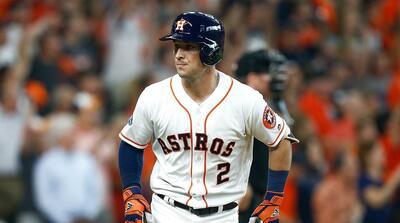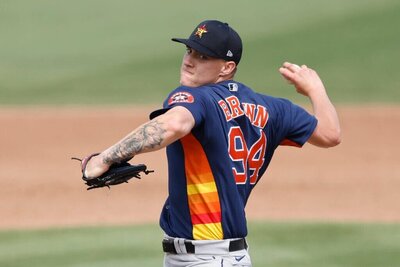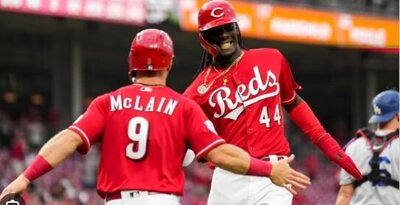Derek Holland (SP - TEX): A perplexing year for Derek Holland continued as he tossed 5 shutout innings against the Yankees before imploding in the 6th inning and allowing 4 ER's. He finished the start having allowed 5 hits and those 4 ER's without walking a batter and striking out 3 in his 5 2/3 innings of work. Holland did a good job keeping the ball on the ground in this outing (52.3% GB Rate), but for the season his GB numbers have taken a step back (42.4%). While Holland has modestly improved his K Rate and his BB Rate, the big drop in GB's has allowed his HR/9 rate to expand significantly and along with it the ERA. In addition to the dip in GB's, Holland's FB velocity has also come back down to 92-93 mph after spiking last year at 94 mph. These aren't monstrous drop-offs in performance, but the environment in Texas leaves very little room for error and Holland has experienced that. Still, there are some reasons for optimism. Holland's average FB velocity on Thursday was back up around 93.5 mph and his K Rate and GB Rates have been building so far in August. I've seen a few interviews where Holland has indicated he feels close to putting it altogether and the metrics of late, seem to agree. With a favorable two-start week ahead against Baltimore and Minnesota, I'd confidently deploy Holland in my lineups.
Trevor Plouffe (3B/SS/OF - MIN): Plouffe has looked lost at the plate since returning from the DL, going 0-12 with 4 K's in his first 3 games since coming back. Plouffe's inconsistent month-to-month performance makes evaluating his 2012 season a bit of a challenge. In the first two months of the year Plouffe struggled despite showing modest improvements in his approach, posting OPS of .517 and .654 respectively. But something clicked in an unusual way in June as Plouffe went on a rampage hitting .327/.391/.735 with an obscene 31% HR/FB Rate. Things settled back in at a more reasonable clip in July (.302/.343/.476), but Plouffe also showed a much reduced K and BB Rate in the month and put a lot more balls in play. Throw in a thumb injury to the mix (notoriously difficult for hitters to come back from) and there's another challenging variable to consider. If I owned Plouffe I'd be particularly cautious in the next week and continue to watch the K Rate as hitters can have problems adjusting their swing to find comfort in a thumb that is recovering strength. If Plouffe starts to demonstrate the improved contact he showed in July, he's likely to be a pretty valuable asset with the bat down the stretch; especially given his position eligibility. I don't think his season-long .255 ISO is a realistic expectation even when fully healthy, but something along the lines of a .250/.310/.450 batting line the rest of the way wouldn't surprise me. Stay patient if you own and pick your spots short-term while evaluating his long-term value based on the K Rate.
Brett Lawrie (3B - TOR): We've seen some recent news blurbs suggesting Lawrie's status was improving and he may be good enough to return when first eligible on Sunday, but Thursday provided a bit more clarity on the situation. The Blue Jays announced they expect Lawrie to return from his oblique injury on Tuesday (@DET). Lawrie's 2012 season has fallen short statistically for fantasy owners, but to his credit he has shown an ability to bounce back from some nagging injuries rather quickly. His BB Rate, K Rate and ISO have all declined significantly from a breakout 2011 season and look remarkably more in line with his performance at AA in 2010. Given we saw Lawrie have so much success at the big league level last year, it's hard to simply throw it out, but as is the case with all young players we have to realize the development isn't linear. When projecting him going forward, I still see plenty of room for growth in his ISO (.134) and his BB Rate (5.2%). He isn't a hacker at the plate (31% chase rate, 7.1% swinging strike rate), but his approach this year has been a bit more impatient compared to last year. Perhaps with another season under his belt and lowered expectations, Lawrie can get back to a more disciplined approach that unlocks some of the power and helps Lawrie deliver on fantasy owners' expectations next year. His counting total rates (R, RBI) are very close to last season, mostly in part to an improved lineup around him (Encarnacion's breakout + Rasmsus) and I think that's a good sign for Lawrie next season. While he failed to deliver this year and may face challenges in the closing months in his recovery from an oblique strain coupled with a weakened lineup around him, I think he's a nice long-term value in keeper leagues and someone who will probably be more fairly valued heading into 2013.
Dan Haren (SP - LAA): Through three innings it was looking like a pretty normal Dan Haren outing. He allowed a solo HR to Ben Zobrist in the 3rd inning, but was otherwise smooth allowing just that one hit and striking out two. The fourth inning, however, did not go so well. Haren allowed another solo HR to BJ Upton then four consecutive singles, a sac fly, and another single before getting pulled. The final line: 3 2/3 IP, 7 hits, 5 ER's, 0 BB's, and 2 K's has unfortunately been all too familiar this season for Haren owners. I wrote extensively about Haren a few weeks back in this space and noted that Haren's transition to the AL was an immediate downgrade to a mid-rotation starter based on his history of performance in the AL. This year, unfortunately, it's been even worse than a mid-rotation starter because of an elevated LD Rate and HR/FB Rate that is being driven by lower FB velocity (avg 88.6 mph). Given we've seen little sign in Haren's ability to recover that velocity, I'm starting to believe the elevated LD rates and HR/FB Rates might be here to stay. As a result I'm downgrading him even further to just a spot-starter. With matchups coming up against BOS in consecutive starts I'll be sitting them out as a Haren owner.
Dan Straily (SP - OAK): I watched Straily pretty intently on Thursday night as I was trying to identify the pretty large gap in the perception between Straily's minor league performance and the scouts view of his major league future. It didn't take long to see why Straily was dominant at the minor league level and why so far his performance has been mixed at the major league level. Straily worked consistently from ahead, generating a number of 0-2 counts, but struggled to finish off hitters; generating just two strikeouts in 6 1/3 innings of work. Because he was working from ahead, Straily was able to induce weaker contact (10.5% LD Rate, 33% infield-fly-ball rate) and as a result he limited the Royals to just 3 hits while shutting them out. Straily continued to struggle keeping the ball on the ground (42% GB Rate) which will make him a volatile option going forward, but the combination of strong command (2.12 BB/9) and the Coliseum should make him a nice spot-start option when at home. When Straily was promoted I compared his performance to something like what we saw out of AJ Griffin and I think that's a reasonable expectation going forward. He's going to struggle with HR's at times and owners should be careful using him against elite offenses, but I think he has a spot-starter on most teams. The big question with Straily (for me) isn't necessarily performance but whether is grasp on the rotation spot is firm with Brett Anderson working his way back. The solid start should earn him a longer leash, but much will depend on his next start at home against Minnesota.
Follow us on Twitter all year: @Fantistics and @drewdinkmeyer
These are only a few of the players we are covering today. We profile over 100 players everyday in our premium section, become a member today.


































